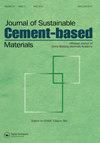煅烧工艺对工业废渣中富铁酸钙硅酸盐水泥熟料铁酸盐相和硅酸盐相的影响
IF 4.2
3区 工程技术
Q1 CONSTRUCTION & BUILDING TECHNOLOGY
Journal of Sustainable Cement-Based Materials
Pub Date : 2023-09-15
DOI:10.1080/21650373.2023.2258124
引用次数: 0
摘要
摘要利用具有潜在胶凝活性的工业固体废弃物制备富铁酸盐-白石硅酸盐水泥熟料。研究了固废组成、生料比、煅烧温度、保温时间等因素对熟料中铝酸铁相和硅酸盐相类型及含量的影响。简要讨论了烟气脱硫石膏对熟料力学性能、矿物组成和硬化浆料微观结构的影响。此外,采用生命周期评价法对富铁酸钡硅酸盐水泥熟料生产的可持续性进行了评价。分析结果表明:(1)铁素体相含量随煅烧温度的升高先升高后降低,硅酸盐相和铁素体相含量随保温时间的延长先升高后降低。(2)随着煅烧温度的变化,硅酸盐相始终呈鹅卵石状且分布均匀。铁素体相由粒状或片状变为枝状,最后被液相吞噬,填充在硅酸盐相结构的间隙之间,或附着在硅酸盐相的表面。(3)熟料中的Si元素总是聚集成鹅卵石状,大小不均匀。随着保温时间从30 min增加到60 min, Al和Fe元素在硅酸盐相间隙中的分布面积逐渐增大。部分铝、铁元素分布在硅酸盐相矿物所在区域。保温时间延长至90min后,Fe和Al元素趋于随机分布。(4)在C4AF水化过程中,Fe会取代部分Al形成Fe-钙矾石、Fe-硅质水榴石等。(5)利用赤泥、电石渣、硅灰生产富铁氧体-白铁矿硅酸盐水泥熟料,可减少57.50%的碳排放。关键词:富铁酸盐-白石硅酸盐水泥熟料煅烧保温时间矿物成分微观结构致谢本文得到了山东省重大科技创新专项、国家重点研发计划和山东省自然科学基金重点项目的支持。披露声明作者未报告潜在的利益冲突。项目资助:山东省重大科技创新项目[批准号:2020CXGC011405和批准号:2021CXGC010301]、国家重点研发计划[批准号:2022YFB2601900]、山东省自然科学基金重点项目[批准号:2022YFB2601900];2020 ke006]。本文章由计算机程序翻译,如有差异,请以英文原文为准。
Effect of calcination process on ferrite phase and silicate phase of ferrite-belite-rich Portland cement clinker from industrial solid waste
AbstractIn this paper, the industrial solid waste with potential cementitious activity was used to prepare ferrite-belite-rich Portland cement clinker. The changes in solid waste composition, raw meal ratio, calcination temperature, and holding time on the type and content of iron aluminate phase and silicate phase in the clinker were studied. The effects of flue gas desulfurization gypsum on the mechanical properties of clinker, mineral composition, and microstructure of hardened slurry were briefly discussed. In addition, the sustainability of the production of ferrite-belite-rich Portland cement clinker was evaluated by using a life cycle assessment. The analysis results show that: (1) The content of the ferrite phase increased first and then decreased with the increase of calcination temperature, and the content of the silicate phase and ferrite phase increased first and then decreased with the extension of holding time. (2) With the change of calcination temperature, the silicate phase is always cobblestone-like and evenly distributed. The ferrite phase changes from granular or flake to branch dendritic, and finally is swallowed by the liquid phase, filled between the gaps of the silicate phase structure, or attached to the surface of the silicate phase. (3) The Si elements in the clinker are always agglomerated in cobblestone shapes with uneven sizes. With the holding time from 30 min to 60 min, the distribution area of Al and Fe elements in the gaps of silicate phases increased gradually. Some Al and Fe elements are distributed in the area where silicate phase minerals are located. When the holding time is extended to 90 min, Fe and Al elements tend to be randomly distributed. (4) Fe will replace part of Al to form Fe-ettringite, Fe-siliceous hydrogarnet, etc. in the hydration process of C4AF. (5) The use of red mud, carbide slag, and silica fume to produce ferrite-belite-rich Portland cement clinker will reduce carbon emissions by 57.50%.Keywords: Ferrite-belite-rich Portland cement clinkercalcination temperatureholding timemineral compositionmicrostructure AcknowledgmentThe authors acknowledge the support of this work was supported by the Major Scientific and Technological Innovation Projects in Shandong Province, the National Key R&D Program of China and the Key Projects of Natural Science Foundation of Shandong Province.Disclosure statementNo potential conflict of interest was reported by the author(s).Additional informationFundingThis work was supported by the Major Scientific and Technological Innovation Projects in Shandong Province [Grants Nos. 2020CXGC011405 and Grants Nos. 2021CXGC010301], the National Key R&D Program of China [Grants Nos. 2022YFB2601900] and the Key Projects of Natural Science Foundation of Shandong Province [No. 2020KE006].
求助全文
通过发布文献求助,成功后即可免费获取论文全文。
去求助
来源期刊
CiteScore
6.60
自引率
15.90%
发文量
71
期刊介绍:
The Journal of Sustainable Cement-Based Materials aims to publish theoretical and applied researches on materials, products and structures that incorporate cement. The journal is a forum for discussion of research on manufacture, hydration and performance of cement-based materials; novel experimental techniques; the latest analytical and modelling methods; the examination and the diagnosis of real cement and concrete structures; and the potential for improved cement-based materials. The journal welcomes original research papers, major reviews, rapid communications and selected conference papers. The Journal of Sustainable Cement-Based Materials covers a wide range of topics within its subject category, including but are not limited to: • raw materials and manufacture of cement • mixing, rheology and hydration • admixtures • structural characteristics and performance of cement-based materials • characterisation techniques and modeling • use of fibre in cement based-materials • degradation and repair of cement-based materials • novel testing techniques and applications • waste management

 求助内容:
求助内容: 应助结果提醒方式:
应助结果提醒方式:


